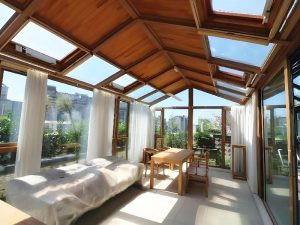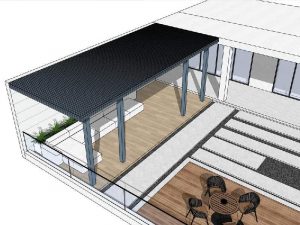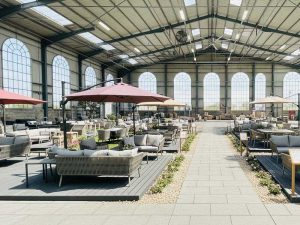Besides the framework, roofing materials play a crucial role in modern pergolas. They not only define the overall style of the pergola but also significantly impact its protective performance, durability, and ease of maintenance. From traditional fabrics to high-tech solar panels, today’s market offers a wide variety of options for pergola roofing materials. These materials not only provide different functions but also create unique styles for your outdoor space.
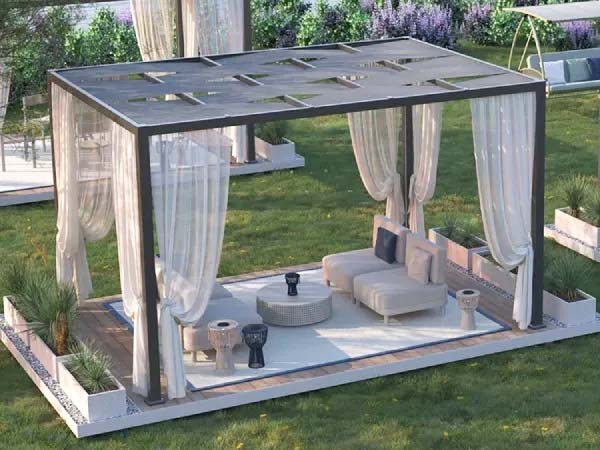
As a company with over 20 years of experience in outdoor shade products manufacturing, LIDA OUTDOOR will discuss eight common pergola roofing materials in detail. We will cover their performance, durability, and cost. Hopefully, this guide will help you choose the best roof material for your pergola.
8 Best Materials for Pergola Roof
In modern pergola designs, materials such as fabric, glass, polycarbonate panels, or galvanized steel are often used for roofing. These materials are durable and effective at providing shade and protection from rain. For DIY enthusiasts, the choices expand even further. For instance, wooden roofs add a natural touch, while solar panels can serve as both a roof and a source of energy to power your pergola’s lights.
Let’s take a closer look at some of the best materials for pergola roofs and their key features:
1. Fabric
Fabric is a lightweight and versatile roofing material that adds a romantic touch to any pergola. Whether waterproof or not, fabric is ideal for creating a Bohemian or rustic pergola style. It creates a relaxed and airy atmosphere, making it a great choice for a cozy outdoor space.

However, fabric has its downsides. While modern fabrics are more durable, they are still susceptible to weather damage and UV rays compared to sturdier materials. Regular maintenance, like cleaning and repairs, is necessary, especially in rainy or dusty environments. Additionally, fabric provides limited shade and protection from the sun or rain, so it’s best suited for partial shade or decorative purposes.
Fabric is one of the most affordable options for pergola roofs. If you live in a mild climate, fabric can be a romantic and practical choice. However, you need to balance aesthetics and functionality when choosing this material.
2. Polycarbonate Panels
Polycarbonate panels are lightweight, versatile, and well-known for their ability to block UV rays. Available in various colors, these panels are a practical pergola roofing material, especially if you enjoy bright, natural light. They are also highly durable, capable of withstanding hail and strong winds.
However, polycarbonate panels can yellow over time due to sun exposure, which may affect their transparency. Additionally, their tendency to expand and contract in varying temperatures can impact their stability.

In terms of cost, polycarbonate panels fall within the mid-range price category. When choosing this material, it’s essential to source high-quality panels from a reliable manufacturer to ensure durability. If you love sunlight and modern designs, polycarbonate panels are a great choice, offering the look of glass at a more affordable price.
3. Glass
Glass is a stylish and modern roofing option for pergolas. Its smooth surface and clean lines make it perfect for contemporary pergola designs. Glass creates a bright, open space that seamlessly connects your pergola with the surrounding environment.
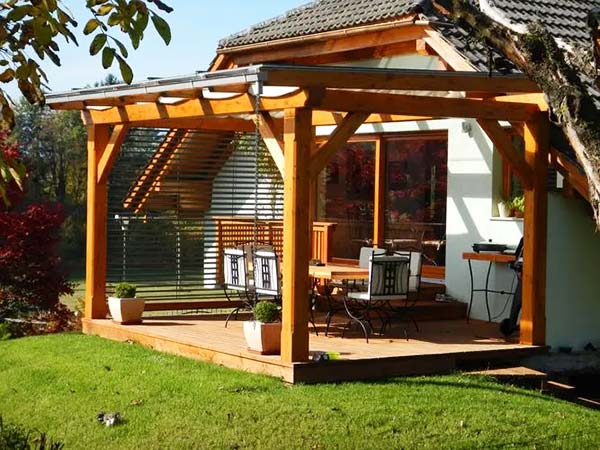
However, glass comes with challenges. Its heavy weight requires a sturdy structure to support it, which can increase construction costs. While modern glass is often tempered for durability, it remains more prone to breakage compared to other materials. The installation process is complex and usually requires skilled professionals, which adds to the cost.
Glass is one of the more expensive pergola roofing materials. You need to balance the aesthetic appeal with safety and durability, especially if you live in areas prone to extreme weather like hail.
4. Metal
Metal roofing is ideal for modern pergolas and is favored for its lightweight nature, low maintenance, and suitability for various weather conditions. Common metals used include aluminum, steel, and iron. Aluminum is an excellent choice for those seeking a lightweight, low-maintenance roof, while steel is perfect for those who prioritize wind and snow resistance.
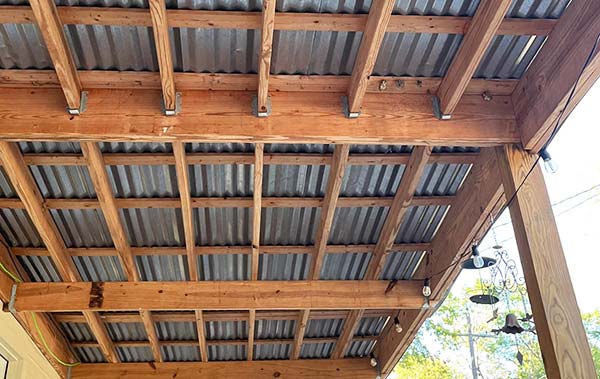
One common issue with metal roofs is condensation. To combat this, insulation layers are recommended, especially for pergolas in hot climates.
The price of metal roofing varies. Premium aluminum or steel may cost more, but they offer excellent value. If you live in a stormy or snowy area, we recommend using heavy steel for better stability and strength.
5. Wood
Wooden roofing adds a natural and rustic charm to pergolas, making it a popular choice for traditional or country-style designs. Different types of wood come with varying price points and characteristics. No matter which type you choose, a wooden roof adds unique visual appeal to any outdoor space.
However, wood requires regular maintenance, including treatments for weather resistance and pest control. While this adds to the cost and effort, the natural beauty of wood makes it a worthwhile choice for those who prioritize aesthetics.
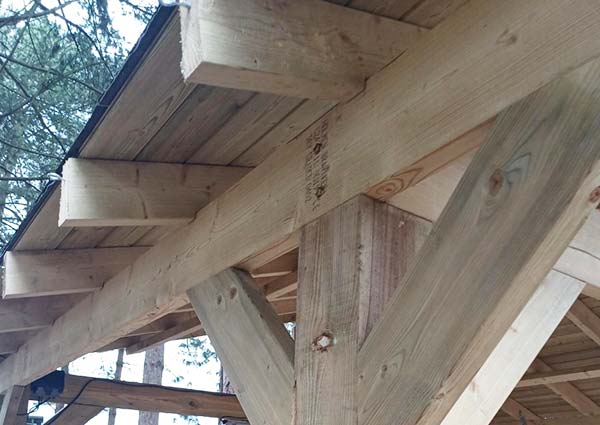
Wood is available at various price points. High-end options like cedar or redwood are more expensive but offer superior quality, while treated pine provides a more budget-friendly option. However, if you live in a humid or rainy climate, wood might not be the best choice due to its maintenance needs.
6. Tiles
Tiles, often made from clay or concrete, are highly weather-resistant and ideal for protecting your pergola from extreme weather. They also provide excellent insulation, keeping your pergola cool during hot weather.
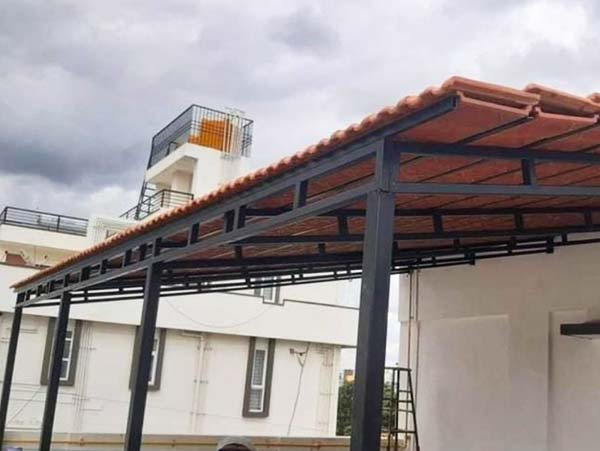
However, tiles are heavy, requiring a strong structure to support their weight, which can increase construction costs. They are best suited for Mediterranean or traditional-style pergolas, such as Japanese or Chinese designs.
While tile roofs are more expensive upfront, they require little maintenance, making them a cost-effective choice in the long run.
7. Bamboo
Bamboo is typically used for both the structure and roof of a pergola, adding a natural, rustic charm. It’s an affordable option, but its high maintenance costs might outweigh the initial savings.
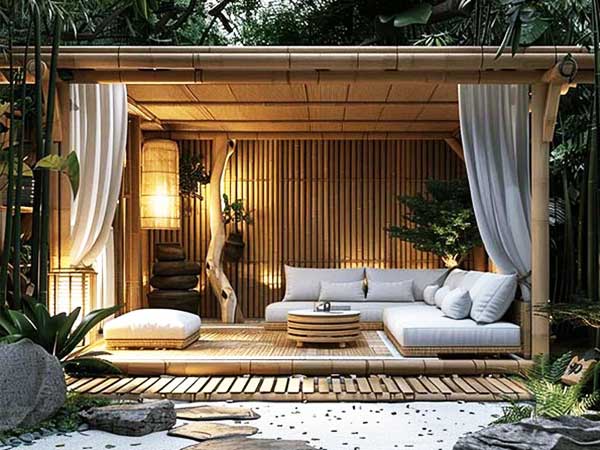
8. Solar Panels
Solar panels are an innovative pergola roofing material that combines functionality with environmental benefits. Not only do they provide shade, but they also convert sunlight into electricity, which can be used to power lights and other garden equipment.
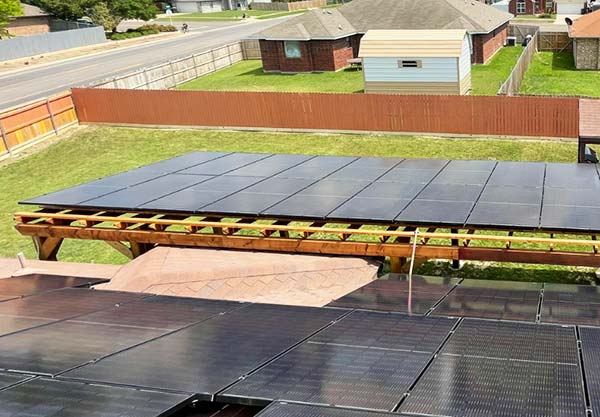
However, solar panels come with high installation costs and depend on adequate sunlight for efficiency. In areas with frequent cloudy weather, the performance of solar panels may be limited.
Despite the higher cost, solar panels are an excellent option for those looking to reduce energy consumption and embrace green living. Consider the climate, budget, and maintenance when choosing solar panels as your pergola roof material.
Conclusion
When selecting the best roof for your pergola, consider factors like aesthetics, functionality, budget, and local climate. Each material has its unique advantages and drawbacks. By carefully assessing your needs and long-term use, you can create a beautiful and practical pergola that enhances your outdoor space.
If you are a wholesaler in the outdoor furniture industry, feel free to contact LIDA OUTDOOR. As an experienced manufacturer of patio shading products in China, we look forward to collaborating with you to expand the outdoor furniture market and achieve mutual success.

